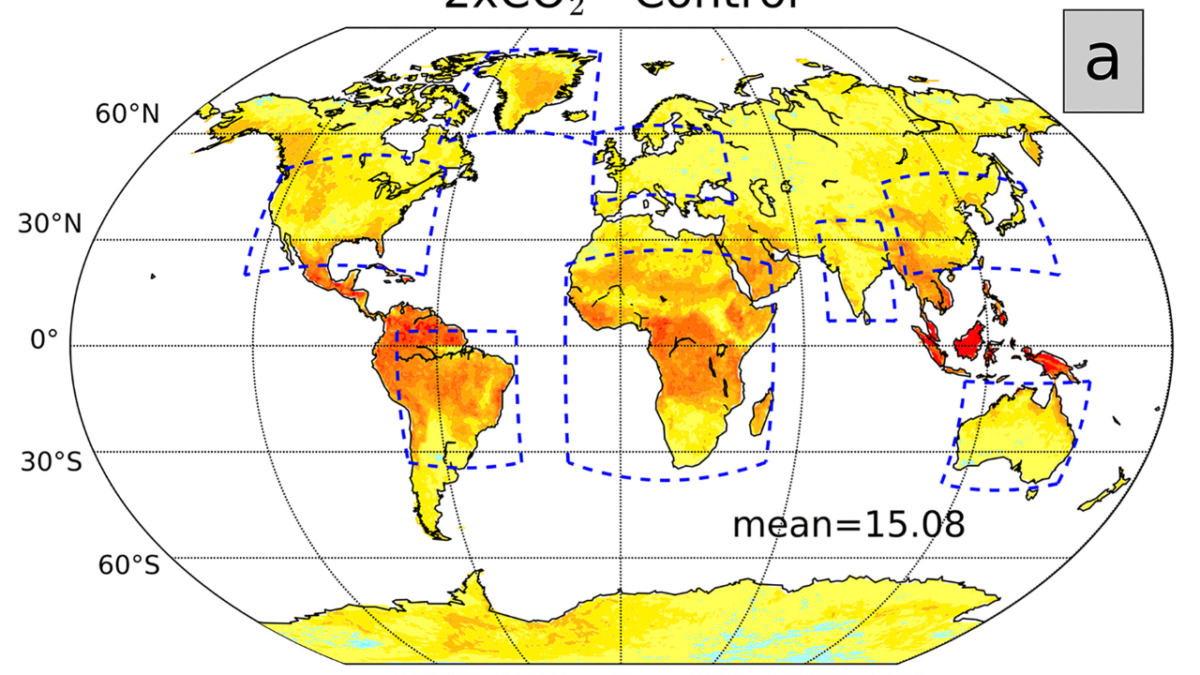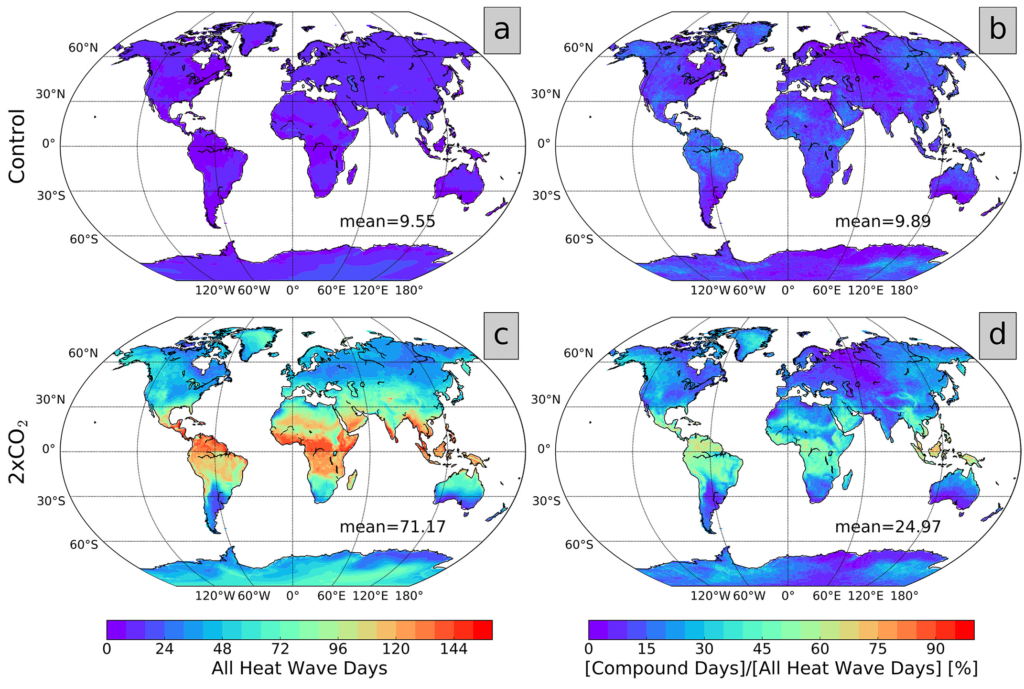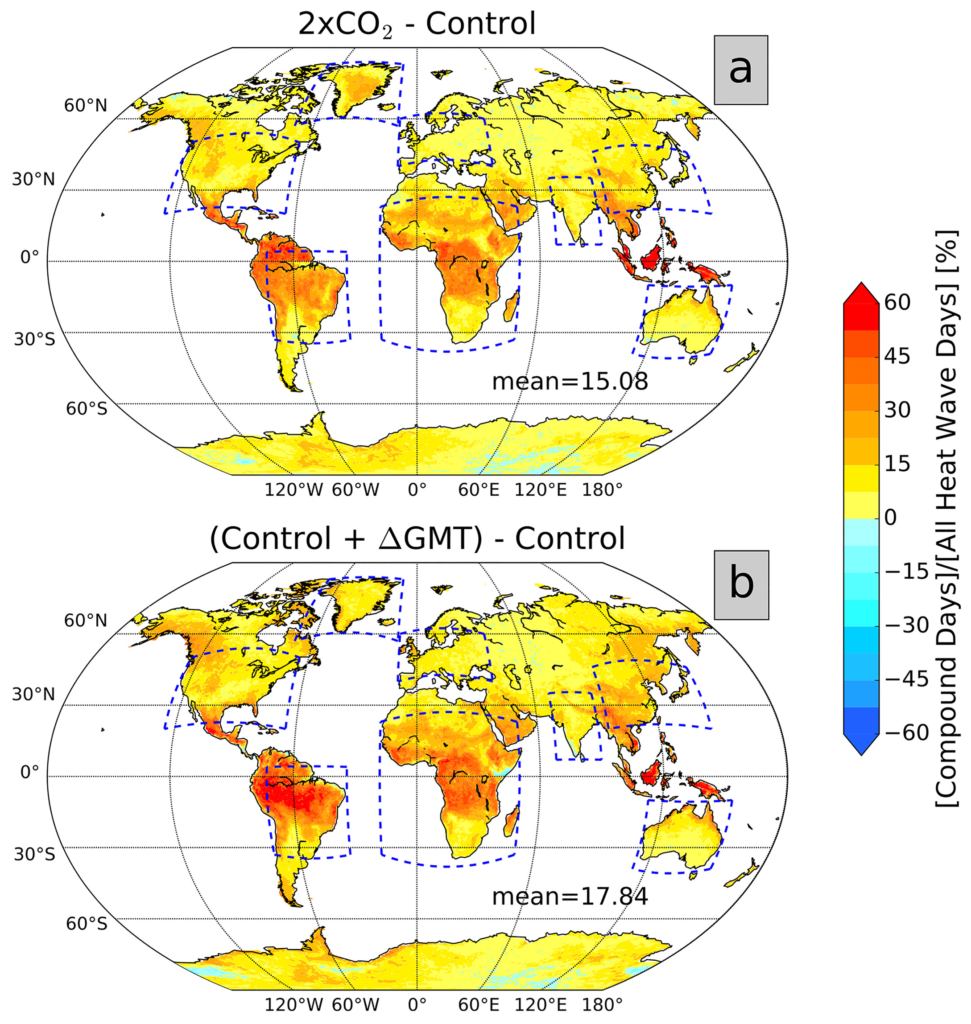Thursday May 16th … Dear Diary. The main purpose of this ongoing blog will be to track United States extreme or record temperatures related to climate change. Any reports I see of ETs will be listed below the main topic of the day. I’ll refer to extreme or record temperatures as ETs (not extraterrestrials).😉
A New Threat…Compound Heat Waves
My ears always perk up when I see new studies in association with global warming related heat. At The Weather Channel I became interested in weather patterns that produced heat waves as early as the 1980s. The main purpose of my site, after all, is to report on extreme heat. A new study has come up introducing the term “compound heat wave,” which is a back to back heat wave across any given area of the planet made more likely by carbon pollution as we move forward in time through this century and beyond. For today’s main topic here is a reposted Desdemona Despair article delving into this new threat:

Occurrence of back-to-back heat waves likely to accelerate with global warming – “Compound heat waves are projected to grow more rapidly than simple heat waves”

Forecast‐oriented Low Ocean Resolution derivative of CM2.5 (FLOR) output heat wave hazard and compound proportion. Control (a and b) and 2xCO2 (c and d) total summer heat wave days (a and c) and proportion of those heat wave days that are compounded in percent terms (b and d), calculated from all 100 years of the model daily minimum temperature data. Daily minimum temperature data are used, the temporal structure definition is 311, and the threshold is the seasonally varying 90th percentile calculated from years 1981–2010, but qualitative results are robust across the range of definitions tested. Global means are noted on each panel. Graphic: Baldwin, et al., 2019 / Earth’s Future
By Joseph Albanese
8 May 2019
(Princeton Environmental Institute) – As the planet continues to warm, multi-day heat waves are projected to increase in frequency, length and intensity. The additive effects of these extreme heat events overwhelm emergency service providers and hospital staff with heat-related maladies, disrupt the electrical grid and can even cause delays in air travel.
But existing studies do not consider the increased loss of life and economic hardship that could come from back-to-back — or compound — heat waves, which bring cycles of sweltering temperatures with only brief periods of normal conditions in between.
Princeton University researchers affiliated with the Princeton Environmental Institute (PEI) now have provided the first estimation of the potential damage wrought by sequential heat waves, according to a paper published 12 April 2019 in the journal Earth’s Future. The authors used computer simulations of Earth’s climate to find that compound heat events will increase as global warming continues and will pose greater risks to public health and safety.
Compound heat waves would be especially dangerous to people who are already vulnerable to heat waves, particularly the elderly and residents of low-income areas. Government warning systems and health care outreach do not currently calculate the escalating risk these populations face from several heat waves in a row, the researchers reported. Instead, risk and response are determined by the severity of each individual episode of extreme temperatures.
Some of the deadliest heat waves on record featured fluctuating temperatures rather than single stretches of searing heat, said first author Jane Baldwin, a postdoctoral researcher in the Princeton Environmental Institute (PEI) who also is supported by the High Meadows Foundation through the Center for Policy Research on Energy and the Environment (C-PREE) in Princeton’s Woodrow Wilson School of Public and International Affairs.
“Averaged over time, heat waves are the most deadly type of natural disaster in the United States, in addition to causing many emergency room visits, lost working hours and lower agricultural yields,” Baldwin said. Heat waves and the droughts that can accompany them are responsible for approximately 20% of the mortalities associated with natural hazards in the continental United States.
“However, if you look at the deadliest heat waves in Europe and the United States, many have more unusual temporal structures with temperature jumping above and below extremely hot levels multiple times,” Baldwin said. Because of the shorter recovery period between events, the effects of these compound heat waves are often significantly worse than stand-alone events.
Co-author Michael Oppenheimer, the Albert G. Milbank Professor of Geosciences and International Affairs and the Princeton Environmental Institute, said that, adding to the urgency, is the fact that “compound heat waves are projected to grow more rapidly than simple heat waves.”
“Our work begins exploring the implications of compound heat waves if climate change continues unchecked,” Oppenheimer said. “We want to know how the effects of compound heat waves will differ from — and amplify — the already severe consequences for human health, infrastructure stability and crop yield that we see from single-event heat waves.”
The researchers ran climate simulations on an advanced model partly designed by co-author Gabriel Vecchi, professor of geosciences and the Princeton Environmental Institute, in conjunction with the National Oceanographic and Atmosphere Administration’s Geophysical Fluid Dynamics Laboratory located on Princeton’s Forrestal Campus. They found that as global temperatures increase, heat waves will become more frequent and the time between them will become shorter.
One heat wave after another will leave emergency service providers and infrastructure-repair crews with less time to recover from the past event before being confronted by new heat waves, Baldwin said. Additionally, those housed in buildings lacking climate control systems will be subjected to even greater periods of heat, as structures tend to retain heat. Citing a recent study, Baldwin noted that “surveys of low-income housing in places such as Harlem have found that after a heat wave has ended, temperatures indoors can remain elevated for a number of days.”
Policymakers and crisis managers will increasingly need to look back to recent events when preparing for future heat waves, as the ramifications may be felt well after the mercury has dropped, the researchers reported. Current heat wave warning systems that are configured to look toward future events might be recalibrated to take preceding heat events into account as well. Failing to account for the added vulnerability created by the cascading effects of compound heat waves may lead to a greater loss of life as global warming continues.
“Ultimately, with more flexible temporal structures in heat-wave warning systems, we think that heat wave impacts might be reduced and more lives might be saved,” Baldwin said. “[T]o facilitate adaptation and policy response, more work is needed to quantify the impacts of these compound heat waves.”
Baldwin points out that the study in Earth’s Future is an imperative first step in understanding the sprawling effects of compound heat waves. The paper is likely to spawn new work. For the next step, the researchers are working to understand in more detail the health risks posed by compound heat waves.
The paper, “Temporally Compound Heat Wave Events and Global Warming: An Emerging Hazard,” was published 12 April 2019 in Earth’s Future. This work was supported by a National Science Foundation Graduate Research Fellowship (DGE 1148900), the PEI-STEP Graduate Fellowship program, the PEI Carbon Mitigation Initiative, and the National Oceanographic and Atmospheric Association’s Climate Program Office.
Occurrence of back-to-back heat waves likely to accelerate with climate change

Change in compound heat wave proportion and bias from synthetically shifting the mean. Differences are shown in compound proportion (percent) between the 2xCO2 and control simulations (a; difference between Figures 3b and 3d) and the control simulation and control + ΔGMT (b). Daily minimum temperature data are used, the temporal structure definition is 311, and the threshold is the seasonally varying 90th percentile calculated from years 401–430 of control, but qualitative results are robust across the range of definitions. The blue dashed rectangles designate regions over which spatial correlations are calculated in Figure 5. GMT = global mean temperature. Graphic: Baldwin, et al., 2019 / Earth’s Future
ABSTRACT: The temporal structure of heat waves having substantial human impact varies widely, with many featuring a compound structure of hot days interspersed with cooler breaks. In contrast, many heat wave definitions employed by meteorologists include a continuous threshold‐exceedance duration criterion. This study examines the hazard of these diverse sequences of extreme heat in the present, and their change with global warming. We define compound heat waves to include those periods with additional hot days following short breaks in heat wave duration. We apply these definitions to analyze daily temperature data from observations, NOAA Geophysical Fluid Dynamics Laboratory global climate model simulations of the past and projected climate, and synthetically generated time series. We demonstrate that compound heat waves will constitute a greater proportion of heat wave hazard as the climate warms and suggest an explanation for this phenomenon. This result implies that in order to limit heat‐related mortality and morbidity with global warming, there is a need to consider added vulnerability caused by the compounding of heat waves.
SIGNIFICANCE: Heat waves are multiday periods of extremely hot temperatures and among the most deadly natural disasters. Studies show that heat waves will become longer, more numerous, and more intense with global warming. However, these studies do not consider the implications of multiple heat waves occurring in sequence, or “compounding.” In this study, we analyze physics‐based simulations of Earth’s climate and temperature observations to provide the first quantifications of hazard from compound heat waves. We demonstrate that compound events will constitute a greater proportion of heat wave risk with global warming. This has important policy implications, suggesting that vulnerability from prior heat waves will be increasingly important to consider in assessing heat wave risk and that heat wave warning systems that currently primarily consider future‐predicted weather should also account for the recent history of weather.
Temporally Compound Heat Wave Events and Global Warming: An Emerging Hazard
Here is a link from Princeton:
For another take on the same article read:
The United States has yet to experience a heat wave during 2019. I am beginning to see from meteorological models that we may have one across the Southeast and perhaps the Middle Atlantic and as far north as the Ohio Valley as we move towards June. We will see.
………………………………………………………………………………………………………..
Here is some more climate and weather news from Thursday:
(As usual, this will be a fluid post in which more information gets added during the day as it crosses my radar, crediting all who have put it on-line. Items will be archived on this site for posterity. In most instances click on the pictures of each tweet to see each article.)
Here is are some “ETs” from Thursday:
(If you like these posts and my work please contribute via the PayPal widget, which has recently been added to this site. Thanks in advance for any support.)
Guy Walton- “The Climate Guy”